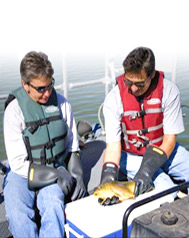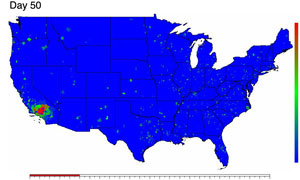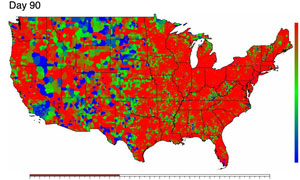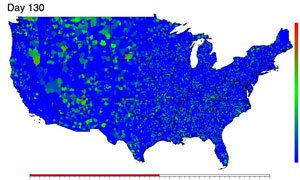About LANL
About Our Capabilities, Facilities, and Staff
"Los Alamos National Laboratory plays an indispensable role in building America as a science and technology powerhouse, and our staff are an incredible resource to the nation and the world." Michael Anastasio, Dir.
Solving Complex R&D Problems with Special Blend of Staff, Capabilities and Facilities
Now in its seventh decade, LANL remains among a very few laboratories that can bring great breadth of fundamental and discovery science, technology, and engineering rapidly together to create tangible solutions for national security needs.
Our staff, working with partners throughout science and industry, must be able to deliver today's solutions while maintaining the depth of capabilities to deliver the next generation of discoveries.
Los Alamos has demonstrated a cycle of innovation where we have developed world-leading capabilities and facilities in response to urgent, unique missions. We also spin out new discoveries that lead to emerging missions.
Being able to integrate and apply our capabilities rapidly to new challenges will be a key advantage in an increasingly competitive landscape.
Our Science, Technology and Engineering Priorities
Science that Matters
- Information science and technology enabling integrative and predictive science
- Experimental science focused on materials for the future
- Fundamental forensic science for nuclear, biological, and chemical threats
How We Work
- Collaborate, partner and team to make decisive contributions to our sponsors
- Outstanding operational excellence for safety, security, and efficient pursuit of ST&E for our missions
Transform Our Scientific Campus
- Campus for 2020 (consistent with complex transformation)
- Modern science facilities: LANSCE refurbishment, CMR replacement, Science Complex
- Signature facilities for experimental science (MaRIE) and computational science (Roadrunner)
More About This Science
Large-scale, Stochastic Simulation Model Uses Supercomputers
Supercomputer Thwarts Flu
Detecting weak areas in our vaccine distribution infrastructure

Quick read
The Lab's rock-solid model improves national emergency response, protecting our homeland from rapidly spreading pathogens.
Using supercomputers to respond to a potential national health emergency, scientists have developed a simulation that makes stark predictions about an avian influenza pandemic. This model helps providers stockpile vaccines appropriately and prepare emergency response—vital actions for containing a rapidly spreading pathogen or bio threat.
The large-scale, stochastic simulation model examines the nationwide spread of a pandemic influenza virus strain, such as an evolved avian H5N1 virus, should it become transmissible human-to-human. The simulation rolls out a city- and census-tract-level picture of the spread of infection through a synthetic population of 281 million people over the course of 180 days and examines the impact of interventions, from antiviral therapy to school closures and travel restrictions, as the vaccine industry struggles to catch up with the evolving virus.
"Based on the present work, we believe that a large stockpile of avian influenza-based vaccine containing potential pandemic influenza antigens, coupled with the capacity to rapidly make a better-matched vaccine based on human strains, would be the best strategy to mitigate pandemic influenza," say the authors of a National Academy of Sciences publication, Timothy Germann, Kai Kadau, Ira Longini, and Catherine Macken.
"It's probably not going to be practical to contain a potential pandemic by merely trying to limit contact between people, but we find that these measures are useful in buying time to produce and distribute sufficient quantities of vaccine and antiviral drugs," said Germann of Los Alamos' Applied Physics Division.
"Based on our results, combinations of mitigation strategies, such as stockpiling vaccines or antiviral agents, along with social distancing measures could be particularly effective in slowing pandemic flu spread in the U.S.," added the University of Washington's Longini.
The results show that advance preparation of a modestly effective vaccine in large quantities appears to be preferable to waiting for the development of a well-matched vaccine that may not become available until a pandemic has already reached the United States.
"Because it is currently impossible to predict which of the diverging strains of avian H5N1 influenza virus are most likely to adapt to human transmission, studies of broadly cross-reactive avian-influenza based vaccines with even modest immunogenicity in humans are important," said Macken, an influenza researcher in the Los Alamos Theoretical Division. Ideally, both vaccine strategies would be done in parallel: stockpile a vaccine to use while the more effective one is being developed.
How it all Computes
The computer simulation models a synthetic population that matches U.S. census demographics and worker mobility data by randomly assigning the simulated individuals to households, workplaces, schools, and the like. Department of Transportation travel data is used to model long-distance trips during the course of the simulation, realistically capturing the spread of the pandemic virus by airplane and other passenger travel across the United States.
"In the highly mobile U.S. population, travel restrictions alone will not be enough to stop the spread; a mixture of many mitigation strategies is more likely to be effective than a few strictly enforced ones," said Kadau, also of Los Alamos' Theoretical Division.
The model of disease transmission involves probabilities that any two people in a community will meet on any given day in any one of a number of settings, such as home or workplace. Thus, simulated disease transmission is more likely for two people in the same household and less likely for two people who have less in common. "So we are only computing the probability of any person becoming infected on any given day, and a roll of the dice is needed to decide whether they are infected or not," said Germann.
Other elements of randomness modify the simulated disease course. A significant fraction of infected people (33 percent in the present model) never develop clinical symptoms, although they are themselves infectious. In addition, the durations of the incubation and infectious periods can vary and are randomly chosen from distribution functions for each individual, involving more throws of the virtual dice.
"Computer models serve as virtual laboratories where researchers can study how infectious diseases might spread and what intervention strategies may lessen the impact of a real outbreak," said Jeremy M. Berg, director of the National Institute of General Medical Sciences. "This new work exemplifies the power of such models and could aid policymakers and health officials as they plan for a possible future pandemic."
The pandemic simulation model has been implemented in the Laboratory's celebrated scalable parallel short-range molecular dynamics (SPaSM) large-scale simulation platform developed for the nuclear weapons program. It runs on the Los Alamos supercomputer known as Pink, a 1,024-node (2,048 processor) LinuxBIOS/BProc "Science Appliance" running Clustermatic 3, the largest single-system image Linux cluster in the world.
The project's research team includes scientists from Los Alamos National Laboratory, the University of Washington, Emory University, and the Fred Hutchinson Cancer Research Center in Seattle.
Images and Quicktime video of the computer simulation are available at http://www.lanl.gov/news/images/avianflu.shtml online.

Robinson and Fresquez monitor air, soil, animals, plants
Data looks very favorable as the Lab continues working to mitigate its impact on the environment
Fresquez and his team are sampling lakes and rivers to determine the source and migration of potential contaminants.
Currents, the Laboratory's monthly employee magazine, highlighting people in the workplace.










